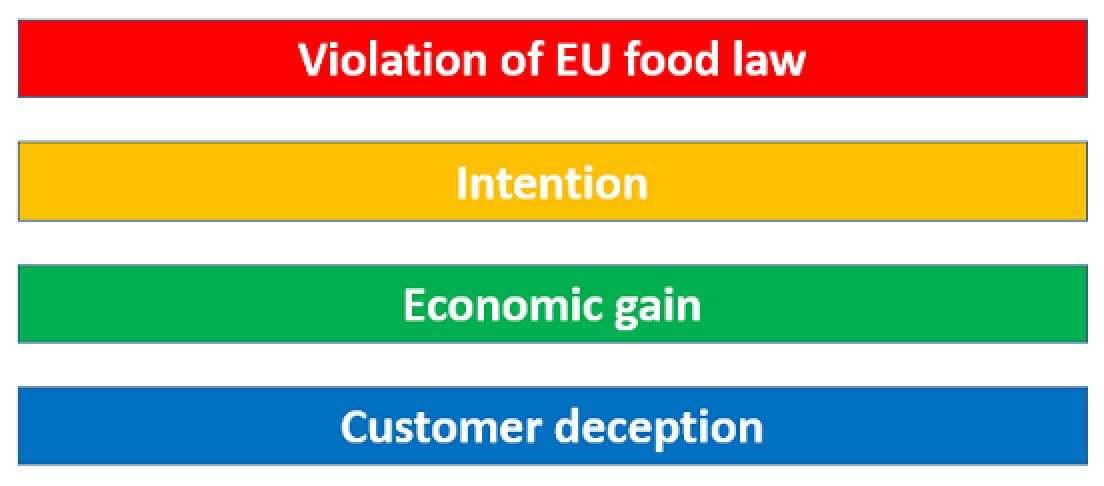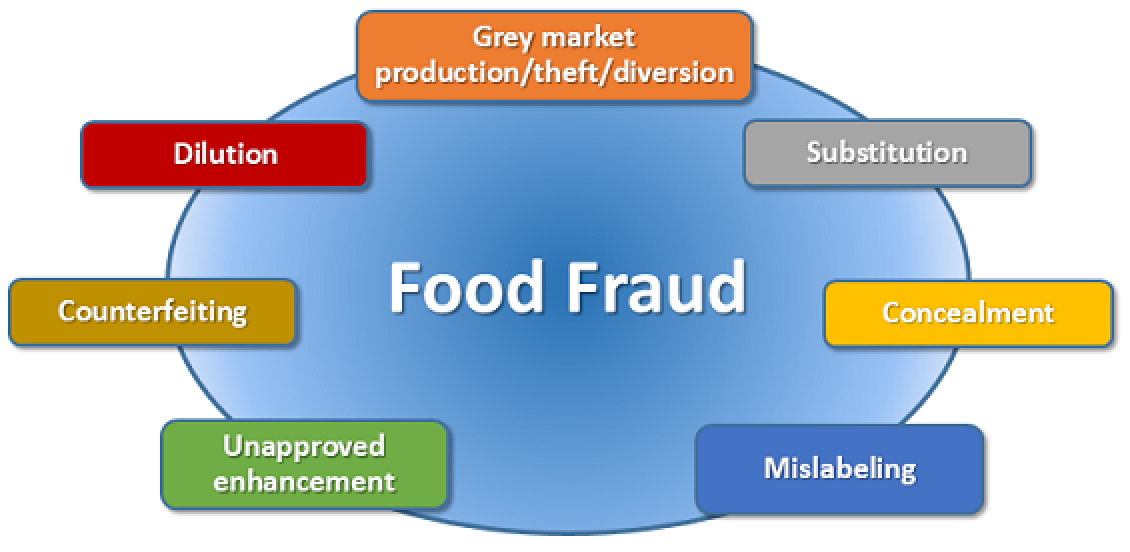The fight against food fraud calls for a global approach involving cooperation and consultation among all stakeholders at all levels of the food chain. Investigations carried out by Europol suggest that organised crime syndicates are increasingly behind cases of food fraud and adulteration. Consequently, the detection and prevention of food fraud requires strategic planning and investment at national and European level involving a substantial budget.
Definition of Food Fraud
- CEN Workshop Agreement 86 Food fraud: intentionally causing a mismatch between food product claims and food product characteristics.
- CX/FICS 18/24/7 Food fraud: any deliberate action of businesses or individuals to deceive others in regards to the integrity of food to gain undue advantage. Types of food fraud include but not limited to: adulteration, substitution, dilution, tampering, simulation, counterfeiting, and misrepresentation.
- OCR Regulation (EU) 2017/625, Article 9, General rules on official controls:
1. Competent authorities shall perform official controls on all operators regularly, on a risk basis and with appropriate frequency, taking account of:
[….] any information indicating the likelihood that consumers might be misled, in particular as to the nature, identity, properties, composition, quantity, durability, country of origin or place of provenance, method of manufacture or production of food.
2. Competent authorities shall perform official controls regularly, with appropriate frequencies determined on a risk basis, to identify possible intentional violations of the rules [….] perpetrated through fraudulent or deceptive practices, and taking into account information regarding such violations shared through the mechanisms of administrative assistance
Fraud in the context of food means that the description of the origin of food, its composition and how it has been obtained and/or prepared, shall be truthful, i.e. nothing of lesser economic value must be added, or removed if it is of higher economic value. If food is misdescribed, i.e. the information about origin, composition, etc provided to customers is not true and if this misdescription is done with the intention to deceive the customer for financial gain, food fraud - also known as economically motivated adulteration - is committed. Economically motivated adulteration of food is estimated to create damage of around € 8 to 12 billion per year. EU citizens have the right to be protected from such practices and to receive accurate information about the food they choose to purchase.
Key Characteristics of the Food Fraud
The key characteristics in any definition of a food fraud are, as follow:

Type of Food Frauds
Several types of fraud exist, as it can be seen in the figure below. They can appear alone or in a combination in the food fraud.

- Dilution - mixing a liquid ingredient of high value with a liquid of lower value.
- Substitution - replacing an ingredient, or part of the product, of high value with another ingredient, or part of the product of lower value.
- Concealment - hiding the low quality of food ingrediends or product.
- Mislabeling - placing false claim on packaging for economic gain.
- Unapproved enhancement - adding unknown and undeclared materials to food products to enhance the quality attributes.
- Counterfeiting - copying the brand name, packaging concept, recipe, processing method, etc. of food products for economic gain.
- Grey market production/theft/diversion - sale of excessunreported product.
Top most common food frauds
According to the scientists, these foods are the most common sources of food fraud: olive oil, milk, honey, saffron, orange juice, apple juice, grape wine, vanilla extract and fish. Different international organisations are working in the development of the trustable methods for food analysis and determination fo the frauds. For some of the food there are already developedseveral methods of analysis, as follow:
- Methods of analysis of Honey (PDF) (International Honey Commission (IHC))
- Methods of analysis of Wine (International Organisation of Vine and Wine (OIV))
- Methods of analysis of Olive Oil (International Olive Council (IOC))
| Originally published | 18 Sep 2018 | 14 Jan 2020 |
| Knowledge service | Metadata | Food Fraud and Quality |
| Digital Europa Thesaurus (DET) | Foodfood fraudEU food chain |
